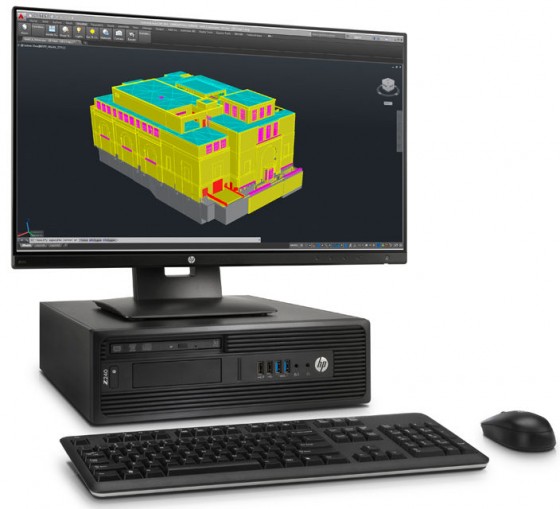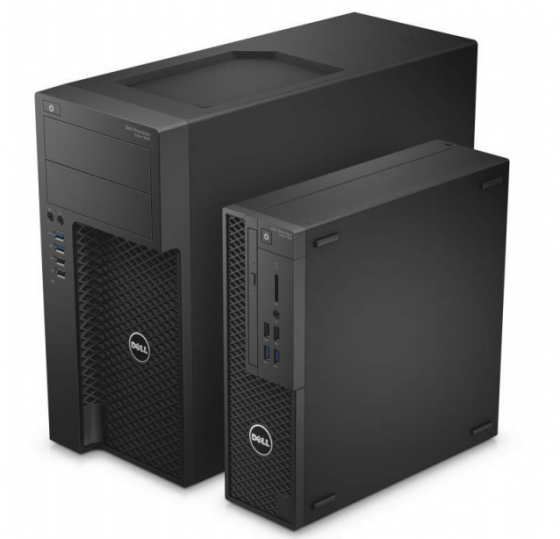HP and Dell out of the chute with new mobile and entry deskside models
By Alex Herrera
Intel has launched a new generation of CPUs, and all the workstation vendors are now launching products to match. It hasn’t always been this way. When it came to timing of new product releases, the vertically integrated workstation vendors of yore—like Sun, SGI, HP, and IBM—were beholden to no schedule but their own. But that’s no more, as today’s workstation OEMs march universally to the beat of but one drummer, Intel. With the processor supplier now virtually the sole supplier of workstation platforms, Intel’s schedule becomes the workstation vendor’s schedule. And when Intel banged that drum with the release of its Skylake generation processors and platforms, it was no surprise to see a slew of workstation models launched in conjunction.

Mobiles and entry desksides now; premium desksides later. Most appropriate for workstation applications are the performance and mission-critical oriented SKUs of this first round of quad-core Skylake processors, including Xeon E3-1200 v5 and Core i7-6000 series products. Most contain silicon integrated GPUs—what Intel has historically referred to as its Processor Graphics—and therefore appeal to not all but a specific subset of today’s workstation market spectrum: entry desksides and mobile workstations.
In a future round, anywhere from two to four quarters away, we will likely see another spin of Skylake, designated Skylake-E. We don’t know if Intel is already publicly talking about a Skylake-E, but it doesn’t take much of a crystal ball to see it coming, as the progression has become the company’s standard operating procedure (witness preceding generations Sandy Bridge, Ivy Bridge, and Haswell). This next set would then contain SKUs targeting servers and high-end desksides and workstations, offering more CPU cores and dual-socket support, while forgoing integrated graphics (in most, if not all, cases). As such, workstation OEMs’ dual-socket and premium single-socket models will wait on their Skylake upgrades until sometime in 2016.
HP Z240
The current workstation market leader, HP, not only ships the highest volume workstation model worldwide, the Z200-series, it was also the first to shrink that model down into a Small Form Factor (SFF) version. Introduced in 2009, the SFF workstation has grown to become the highest growth segment in the market, already accounting for nearly a third of all entry-class workstation shipments.
As expected, HP upgraded its previous Z230, both minitower and SFF models, with Skylake, resulting in the new Z240. With a 57% smaller size than the mini-tower, the SFF model provides customers with two very different packages, depending on customers’ specific demands on performance, capacity, and space. While the timing of new models might be dictated by Intel, what an OEM bakes into each revision is not. Like every supplier, HP uses the opportunities to improve on its workstation products, from advancing reliability, performance, and ergonomics, to reducing power consumption and enhancing ergonomics.

With the Z240, HP touched on a range of design points. Perhaps most significantly, HP has now extended its Z Turbo PCIe SSD to the low end. The PCIe interface, complemented by the recent NVMe software standard, allows bandwidth and latency to substantially exceed what SSDs can manage on the conventional SATA interface that had been shaped more to support conventional hard-drive technologies. Furthermore, the Z240’s Z Turbo G2 option leverages an M.2 slot, allowing HP to free up a PCIe slot that the first-generation Z Turbo required. In addition, HP improved airflow efficiency, particularly around the processor, complemented by an optional dust filter. Both help keep the system cool, and since cooler components are less prone to fail, enhancing airflow efficiency directly leads to superior reliability. For operating system options, it’s worth noting that HP offers both Windows 10 and Windows 7 versions, omitting Windows 8. That choice makes perfect sense, since the vast majority of the installed workstation base passed on Windows 8 prior to Windows 10, and now that 10 is here, we can’t imagine who would be looking for 8. HP typically co-announces a round of mobile workstation refreshes in conjunction with their entry deskside, but that does not appear to be the case this time. Regardless, we’d expect to see the company roll out Skylake-upgraded versions of their ZBook line shortly.
Dell announces Skylake updates for Precision line
After a long decline in market share during the 00’s, Dell, now the number two provider of workstations, has over the last few years developed a sharper, renewed focus on the market. That focus has resulted in aggressive schedules, conscientious designs, and broader product line. On October 1, Dell announced a revamp of its entire Precision mobile workstation line, along with a replacement of its entry deskside Precision T1700 workstation with a pair of new Skylake-based Precision machines, the Tower 3620 and the SFF. The company says all new models will be available early in the fourth quarter of 2015.

Dell’s revamped Precision 3000 minitower carries sensible specifications, not surprisingly very comparable to HP’s Z240. Dell chose to extend processor choices down to Core i3, while HP bottoms out at Core i5. Dell matches HP’s move to support PCI Express SSDs down to the entry level, though they likely come at a substantial premium to standard SATA SSDs (detailed pricing is not yet available).
When it’s the “small” in a small form factor that appeals the most to a customer, trimming size is a top design consideration. Of course, when you’re already packing workstation-caliber capabilities in the smallest package you offer, it’s hard to downsize. Still, Dell claims that careful engineering allowed the company to cut about 7% out of the 3000 Tower SFF’s predecessor, creating the smallest deskside workstation it’s ever produced. All in all, Dell’s take on a new Skylake-based SFF deskside isn’t all that different from HP’s. The two share very comparable configuration options, although HP has an edge in capacity, whereas Dell has an edge in size. As has become the norm, entry desksides aren’t the only models getting upgrades with the first round of next-generation processor SKUs from Intel. Mobile workstations are typically in line for a refresh as well. In conjunction with the Precision Tower 3000 announcement, Dell also disclosed refreshes of its entire line of mobile machines, including both 15-inch and 17-inch models. Over time, the 15-inch form factor (really 15.6-inch, but commonly referred to as 15-inch) has emerged as the Goldilocks sweet spot of the mobile workstation market—big enough without being too cumbersome—and it has captured the lion’s share of volume.
While vendors HP and Lenovo both emphasize 15-inch models in their mobile workstation portfolios, Dell has three different 15-inch Precision SKUs. With this Skylake refresh, the company maintained that count, albeit with a different numbering scheme. Replacing the previous M2800, M3800, and M4800 are the Precision 15 3000 series—the 3510, 5510, and 7510. Three 15-inch models may seem like a lot to cover the space, but each serves a different purpose: the 3510 for minimal cost, the 5510 for maximum mobility, and the 7510 for the most performance possible in the form factor. And though it’s a far less popular option than the 15-inch form factor, the 17-inch mobile still serves a loyal contingent that demands the largest display and performance available. Accordingly, Dell continues to offer a 17-inch model, now refreshed with Skylake and renumbered as the Precision 17 7000 series (7710). As has become typical, each model offers two (or more) screen options, allowing buyers to pay more to get more, in terms of resolution, viewing angle (with IPS, in-plane switching, over standard twisted nematic LCD), and color range. Dell has also aggressively pushed down PCI Express–based SSDs, providing the option across its entire mobile Precision line. The 7510 and 7710 offer top-end performance, with Nvidia’s newest, top-end, Maxwell-based GPU options, maximum capacity in storage and memory (to 64GB), and even overclocking options (as Intel has relaxed overclocking restrictions in Xeon with Skylake). In contrast, cost and size limitations of the 3510 and 5510 keep memory capacity down to 32 GB and limit GPU options to Intel’s integrated HD 530, and lower-end SKUs from both AMD and Nvidia.
Lenovo at a different pace
Where’s Lenovo in all this? Shouldn’t the number-three workstation vendor be keeping pace with Skylake? Well, it basically is, but its timing is not 100% synchronized with Intel. The company recently introduced two new mobile workstations, the ThinkPad P50 and P70, and has already announced that both will support new Skylake SKUs. As far as a refresh to its entry-class ThinkStation P300 deskside tower, nothing has been announced but we’d be shocked not to see an announcement sometime in the coming weeks.
How to choose?
Which machine is better than which? The more relevant question is, what are the trade-offs? The market is far too competitive to allow for mediocre suppliers and mediocre products. HP and Dell have been in the game for years, and, particularly with the latter re-invigorating its workstation business, both are building well-thought out, high-quality products. As such, we find it odd when we’re asked by a customer who makes the best workstation: vendor A or B or C. The truth is, at this point, it’s not usually a pertinent question, as it’s rare to conclude that one machine is inherently “better” than the other. But that doesn’t mean all vendors’ machines are identical, either.
Ultimately, engineering and design is about trade-offs—balancing cost, aesthetics, performance, reliability, and ergonomics. One vendor’s take on those trade-offs won’t necessarily be wrong, but it will differ from that of another, and it’s those differences that can determine if one solution is more appropriate for a customer’s specific needs. The modestly different choices made by HP and Dell on their new Skylake-powered SFF workstations illustrate just that. HP chose to enhance capacity, while not keeping the machine small, at least compared to the conventional tower. Dell, on the other hand, chose to drive down the size as much as possible, making a few modest compromises in capacity. Dell’s Tower 3000 SFF model is almost 40% smaller in total volume (by Dell’s and HP’s disclosed specs), but HP’s Z240 boasts more storage bays and expansion slots. In the end, both the HP and Dell machines appear to be top-quality products (and we hope to confirm as much with a review in the near future), but which machine will grab your fancy will likely depend on how concerned you are about a crowded office versus how much overhead you desire in capabilities.





